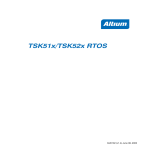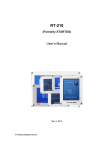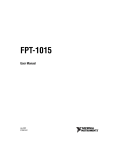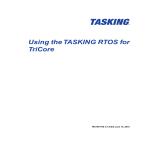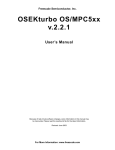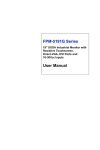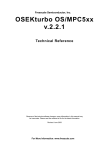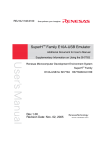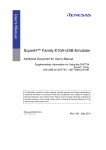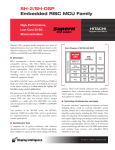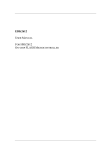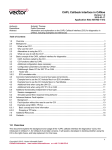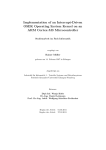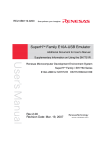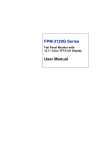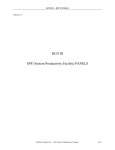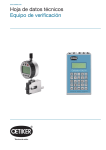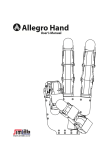Download Ho7000 Series Communication Manual
Transcript
To our customers, Old Company Name in Catalogs and Other Documents On April 1st, 2010, NEC Electronics Corporation merged with Renesas Technology Corporation, and Renesas Electronics Corporation took over all the business of both companies. Therefore, although the old company name remains in this document, it is a valid Renesas Electronics document. We appreciate your understanding. Renesas Electronics website: http://www.renesas.com April 1st, 2010 Renesas Electronics Corporation Issued by: Renesas Electronics Corporation (http://www.renesas.com) Send any inquiries to http://www.renesas.com/inquiry. Notice 1. 2. 3. 4. 5. 6. 7. All information included in this document is current as of the date this document is issued. Such information, however, is subject to change without any prior notice. Before purchasing or using any Renesas Electronics products listed herein, please confirm the latest product information with a Renesas Electronics sales office. Also, please pay regular and careful attention to additional and different information to be disclosed by Renesas Electronics such as that disclosed through our website. Renesas Electronics does not assume any liability for infringement of patents, copyrights, or other intellectual property rights of third parties by or arising from the use of Renesas Electronics products or technical information described in this document. No license, express, implied or otherwise, is granted hereby under any patents, copyrights or other intellectual property rights of Renesas Electronics or others. You should not alter, modify, copy, or otherwise misappropriate any Renesas Electronics product, whether in whole or in part. Descriptions of circuits, software and other related information in this document are provided only to illustrate the operation of semiconductor products and application examples. You are fully responsible for the incorporation of these circuits, software, and information in the design of your equipment. Renesas Electronics assumes no responsibility for any losses incurred by you or third parties arising from the use of these circuits, software, or information. When exporting the products or technology described in this document, you should comply with the applicable export control laws and regulations and follow the procedures required by such laws and regulations. You should not use Renesas Electronics products or the technology described in this document for any purpose relating to military applications or use by the military, including but not limited to the development of weapons of mass destruction. Renesas Electronics products and technology may not be used for or incorporated into any products or systems whose manufacture, use, or sale is prohibited under any applicable domestic or foreign laws or regulations. Renesas Electronics has used reasonable care in preparing the information included in this document, but Renesas Electronics does not warrant that such information is error free. Renesas Electronics assumes no liability whatsoever for any damages incurred by you resulting from errors in or omissions from the information included herein. Renesas Electronics products are classified according to the following three quality grades: “Standard”, “High Quality”, and “Specific”. The recommended applications for each Renesas Electronics product depends on the product’s quality grade, as indicated below. You must check the quality grade of each Renesas Electronics product before using it in a particular application. You may not use any Renesas Electronics product for any application categorized as “Specific” without the prior written consent of Renesas Electronics. Further, you may not use any Renesas Electronics product for any application for which it is not intended without the prior written consent of Renesas Electronics. Renesas Electronics shall not be in any way liable for any damages or losses incurred by you or third parties arising from the use of any Renesas Electronics product for an application categorized as “Specific” or for which the product is not intended where you have failed to obtain the prior written consent of Renesas Electronics. The quality grade of each Renesas Electronics product is “Standard” unless otherwise expressly specified in a Renesas Electronics data sheets or data books, etc. “Standard”: 8. 9. 10. 11. 12. Computers; office equipment; communications equipment; test and measurement equipment; audio and visual equipment; home electronic appliances; machine tools; personal electronic equipment; and industrial robots. “High Quality”: Transportation equipment (automobiles, trains, ships, etc.); traffic control systems; anti-disaster systems; anticrime systems; safety equipment; and medical equipment not specifically designed for life support. “Specific”: Aircraft; aerospace equipment; submersible repeaters; nuclear reactor control systems; medical equipment or systems for life support (e.g. artificial life support devices or systems), surgical implantations, or healthcare intervention (e.g. excision, etc.), and any other applications or purposes that pose a direct threat to human life. You should use the Renesas Electronics products described in this document within the range specified by Renesas Electronics, especially with respect to the maximum rating, operating supply voltage range, movement power voltage range, heat radiation characteristics, installation and other product characteristics. Renesas Electronics shall have no liability for malfunctions or damages arising out of the use of Renesas Electronics products beyond such specified ranges. Although Renesas Electronics endeavors to improve the quality and reliability of its products, semiconductor products have specific characteristics such as the occurrence of failure at a certain rate and malfunctions under certain use conditions. Further, Renesas Electronics products are not subject to radiation resistance design. Please be sure to implement safety measures to guard them against the possibility of physical injury, and injury or damage caused by fire in the event of the failure of a Renesas Electronics product, such as safety design for hardware and software including but not limited to redundancy, fire control and malfunction prevention, appropriate treatment for aging degradation or any other appropriate measures. Because the evaluation of microcomputer software alone is very difficult, please evaluate the safety of the final products or system manufactured by you. Please contact a Renesas Electronics sales office for details as to environmental matters such as the environmental compatibility of each Renesas Electronics product. Please use Renesas Electronics products in compliance with all applicable laws and regulations that regulate the inclusion or use of controlled substances, including without limitation, the EU RoHS Directive. Renesas Electronics assumes no liability for damages or losses occurring as a result of your noncompliance with applicable laws and regulations. This document may not be reproduced or duplicated, in any form, in whole or in part, without prior written consent of Renesas Electronics. Please contact a Renesas Electronics sales office if you have any questions regarding the information contained in this document or Renesas Electronics products, or if you have any other inquiries. (Note 1) “Renesas Electronics” as used in this document means Renesas Electronics Corporation and also includes its majorityowned subsidiaries. (Note 2) “Renesas Electronics product(s)” means any product developed or manufactured by or for Renesas Electronics. To all our customers Regarding the change of names mentioned in the document, such as Hitachi Electric and Hitachi XX, to Renesas Technology Corp. The semiconductor operations of Mitsubishi Electric and Hitachi were transferred to Renesas Technology Corporation on April 1st 2003. These operations include microcomputer, logic, analog and discrete devices, and memory chips other than DRAMs (flash memory, SRAMs etc.) Accordingly, although Hitachi, Hitachi, Ltd., Hitachi Semiconductors, and other Hitachi brand names are mentioned in the document, these names have in fact all been changed to Renesas Technology Corp. Thank you for your understanding. Except for our corporate trademark, logo and corporate statement, no changes whatsoever have been made to the contents of the document, and these changes do not constitute any alteration to the contents of the document itself. Renesas Technology Home Page: http://www.renesas.com Renesas Technology Corp. Customer Support Dept. April 1, 2003 Cautions Keep safety first in your circuit designs! 1. Renesas Technology Corporation puts the maximum effort into making semiconductor products better and more reliable, but there is always the possibility that trouble may occur with them. Trouble with semiconductors may lead to personal injury, fire or property damage. Remember to give due consideration to safety when making your circuit designs, with appropriate measures such as (i) placement of substitutive, auxiliary circuits, (ii) use of nonflammable material or (iii) prevention against any malfunction or mishap. Notes regarding these materials 1. These materials are intended as a reference to assist our customers in the selection of the Renesas Technology Corporation product best suited to the customer's application; they do not convey any license under any intellectual property rights, or any other rights, belonging to Renesas Technology Corporation or a third party. 2. Renesas Technology Corporation assumes no responsibility for any damage, or infringement of any third-party's rights, originating in the use of any product data, diagrams, charts, programs, algorithms, or circuit application examples contained in these materials. 3. All information contained in these materials, including product data, diagrams, charts, programs and algorithms represents information on products at the time of publication of these materials, and are subject to change by Renesas Technology Corporation without notice due to product improvements or other reasons. It is therefore recommended that customers contact Renesas Technology Corporation or an authorized Renesas Technology Corporation product distributor for the latest product information before purchasing a product listed herein. The information described here may contain technical inaccuracies or typographical errors. Renesas Technology Corporation assumes no responsibility for any damage, liability, or other loss rising from these inaccuracies or errors. Please also pay attention to information published by Renesas Technology Corporation by various means, including the Renesas Technology Corporation Semiconductor home page (http://www.renesas.com). 4. When using any or all of the information contained in these materials, including product data, diagrams, charts, programs, and algorithms, please be sure to evaluate all information as a total system before making a final decision on the applicability of the information and products. Renesas Technology Corporation assumes no responsibility for any damage, liability or other loss resulting from the information contained herein. 5. Renesas Technology Corporation semiconductors are not designed or manufactured for use in a device or system that is used under circumstances in which human life is potentially at stake. Please contact Renesas Technology Corporation or an authorized Renesas Technology Corporation product distributor when considering the use of a product contained herein for any specific purposes, such as apparatus or systems for transportation, vehicular, medical, aerospace, nuclear, or undersea repeater use. 6. The prior written approval of Renesas Technology Corporation is necessary to reprint or reproduce in whole or in part these materials. 7. If these products or technologies are subject to the Japanese export control restrictions, they must be exported under a license from the Japanese government and cannot be imported into a country other than the approved destination. Any diversion or reexport contrary to the export control laws and regulations of Japan and/or the country of destination is prohibited. 8. Please contact Renesas Technology Corporation for further details on these materials or the products contained therein. User’s Manual Ho7000 Series Communication Manual Rev.1.0 2002.06 Cautions PLEASE READ THE FOLLOWING CAREFULLY BEFORE YOU USE THIS PRODUCT. 1. If you use the enclosed software product and any related software products (hereafter referred to as “PRODUCT“), before exporting or taking such PRODUCT to other countries or states, you must comply with applicable export control laws and regulations of Japan and other countries with jurisdiction and the applicable states and provinces within Japan and such other countries. 2. Please be advised that Hitachi neither warrants nor grants licenses of any rights to the patents, copyrights, trademarks, or other intellectual property rights owned by Hitachi or any third party for the use of the PRODUCT, unless otherwise expressly granted to you by Hitachi in a contract or other document including without limitation any warranty or license included in the user’s manual for the PRODUCT (hereinafter referred to as “CONTRACTS”). Please be further advised that Hitachi bears no responsibility for problems that may arise with third party’s rights, including intellectual property rights, in connection with the use of the PRODUCT. 3. The PRODUCT, its specifications and/or its description in the user’s manual are subject to change in the future without any prior notice. Confirm that you have received the latest standards and/or specification for the PRODUCT (including the user’s manual) before you make your final design, purchase or use. 4. Please be advised that Hitachi will not have any liability whatsoever for damages, including indirect or consequential damages, arising out of your use of the PRODUCT (including the use based on the descriptions of the user’s manual). Hitachi shall not be liable for any damages caused by any equipment or media used for delivery of the PRODUCT. 5. The PRODUCT is not designed for, and you may not use the PRODUCT for, applications that demand especially high quality and reliability, or where its failure or malfunction may directly threaten human life or cause risk of bodily injury, such as equipment used for aerospace, aeronautics, nuclear power, combustion control, transportation, traffic, safety equipment or medical equipment for life support. If you have any questions regarding whether or not your intended use of the PRODUCT is permitted by Hitachi,, please contact your local Hitachi’s sales office. 6. At the time of designing or planning your system using the PRODUCT, please consider normally foreseeable failure rates or failure modes and employ sufficient systematic measures such as fail-safe systems so that the equipment incorporating the PRODUCT does not cause any accident or other consequential damage due to operation of the PRODUCT. 7. This manual and the PRODUCT are copyrighted by Hitachi. Under any circumstances, you may not copy, analyze, reverse engineer, and/or modify, in whole or in part, the PRODUCT, except to the extent expressly provided in the CONTRACTS. 8. You may not use or copy, in whole or in part, the user’s manual for the PRODUCT without the prior written consent of Hitachi, except to the extent expressly provided in the CONTRACTS. 2 9. You may use the PRODUCT on just one (1) computer. You may not transfer, lease or otherwise assign the PRODUCT to any third party or parties, except to the extent expressly provided in the CONTRACTS. 10. Please contact your local Hitachi’s sales office for any questions regarding the PRODUCT, any Hitachi semiconductor products or any related products. 3 Select the items you want to know from the following flowchart before reading this manual. Yes Overview Ch apt er 1 INTRODUCTION No Operating environments Yes Ch apt er 2 OP ERATING E NVIRONME NTS No Yes F u n ct ion Yes Messa ge fu n ction Sect ion 3.2 Messa ges No No Yes Net wor k set t in gs Sect ion 3.3 Net wor ks No Yes Sect ion 3.4 COM Ar ch it ect u r e COM a r ch it ect u r e No Yes Sect ion 3.5 COM Cont r ol COM oper a t ion Syst em con figu r a t ion Yes Ch apt er 4 SYSTE M CON F IGURATION No Yes Ch apt er 5 P ROGRAMMING P r ogra m m in g No Yes Syst em ser vices Yes Ch apt er 6 AP I DE SCRIP TION AP I No Sect ion 7.1 Comm u n ica t ion Ser vice Ret u r n Codes Sect ion 7.2 Ret u r n Code IDs 4 Table of Contents 1 INTRODUCTION..................................................................................................... 7 1.1 Document Overview .........................................................................................................................................7 1.2 Definitions and Acronyms ...............................................................................................................................7 1.3 COM Overview .................................................................................................................................................7 1.4 Features of This Product .................................................................................................................................9 2 OPERATING ENVIRONMENTS ........................................................................... 11 2.1 Conformity Version........................................................................................................................................11 2.2 Conformance Class.........................................................................................................................................11 2.3 Communication Bus .......................................................................................................................................11 2.4 Operating System ...........................................................................................................................................12 2.5 Notes.................................................................................................................................................................12 3 3.1 FUNCTIONS ......................................................................................................... 13 Function Overview .........................................................................................................................................13 3.2 Messages ..........................................................................................................................................................13 3.2.1 Message Types........................................................................................................................................13 3.2.2 Message Operations................................................................................................................................14 3.2.3 Notification to Application.....................................................................................................................15 3.2.4 Transmission Modes...............................................................................................................................16 3.2.5 Deadline Monitoring...............................................................................................................................20 3.2.6 Message Attributes .................................................................................................................................21 3.3 Networks ..........................................................................................................................................................22 3.3.1 HCAN Related Parameters.....................................................................................................................22 3.3.2 Channel ...................................................................................................................................................22 3.4 COM Architecture .........................................................................................................................................24 3.5 COM Control ..................................................................................................................................................25 3.5.1 Start Up ...................................................................................................................................................26 3.5.2 Normal Operation ...................................................................................................................................26 3.5.3 Shut Down ..............................................................................................................................................26 3.5.4 Error Handling ........................................................................................................................................27 4 4.1 SYSTEM CONFIGURATION ................................................................................ 29 COM Application Building ...........................................................................................................................29 4.2 COM Configuration Files..............................................................................................................................30 4.2.1 Evb ..........................................................................................................................................................31 4.2.2 Hcan ........................................................................................................................................................31 4.2.3 Mcs..........................................................................................................................................................32 4.2.4 Msg..........................................................................................................................................................32 5 PROGRAMMING .................................................................................................. 33 5 5.1 COM Initialisation .........................................................................................................................................33 5.2 Include Files ....................................................................................................................................................33 5.3 Interrupts.........................................................................................................................................................34 5.3.1 HCAN Interrupts.....................................................................................................................................34 5.3.2 Interrupt Priority Levels .........................................................................................................................34 5.4 User Code ........................................................................................................................................................35 5.4.1 Initialisation processing ..........................................................................................................................35 5.4.2 Call-Back Functions ...............................................................................................................................35 5.4.3 HCAN ISR ..............................................................................................................................................36 5.5 Interface to OS................................................................................................................................................37 5.5.1 Interrupt...................................................................................................................................................37 5.5.2 Alarm and Task.......................................................................................................................................37 5.6 Registers...........................................................................................................................................................37 5.7 Stack.................................................................................................................................................................37 5.8 Calling a Communication Service From an Assembler Routine ..............................................................38 5.9 Notes on Assembler Use .................................................................................................................................38 6 API DESCRIPTION............................................................................................... 39 6.1 Standard Interface .........................................................................................................................................39 6.1.1 StartCOM................................................................................................................................................39 6.1.2 MessageInit .............................................................................................................................................40 6.1.3 SendMessage ..........................................................................................................................................41 6.1.4 ReceiveMessage......................................................................................................................................42 6.1.5 GetMessageStatus...................................................................................................................................42 6.2 Original Interface Functions.........................................................................................................................43 6.2.1 OC_SendMsgToNetPer ..........................................................................................................................43 6.2.2 OC_MixedTxEval...................................................................................................................................44 7 APPENDIX............................................................................................................ 45 7.1 Communication Service Return Codes........................................................................................................45 7.2 Return Code IDs .............................................................................................................................................46 7.3 Communication Service Calls .......................................................................................................................47 7.4 Data Types.......................................................................................................................................................47 7.5 Maximum Parameters ...................................................................................................................................47 6 1 INTRODUCTION 1.1 Document Overview This document defines the operation of the Ho7000 series Communication V1 (hereafter referred to as COM) which conforms to the OSEK/VDX (hereafter referred to as OSEK) open standard for communication, Specification Version 2.0a. This document is described on the assumption that OSEK specification is understood. Read this document carefully and understand the contents of the following documents before using this product. - “OSEK/VDX Operating System”, Version 2.0 revision 1 (OSEK/VDX steering committee) “OSEK/VDX Communication”, Version 2.0a (OSEK/VDX steering committee) “OSEK/VDX Communication”, Version 2.1 revision 1 (OSEK/VDX steering committee) Release Notes of this product SuperH RISC engine C/C++ Compiler Package Manual Programming Manual and Hardware Manual of the target SH microprocessor 1.2 Definitions and Acronyms API Application Program Interface CAN Controller Area Network CCC Communication Conformance Class COM Communication for Hitachi Vehicle Operating System DLL Data Link Layer ECU Electronic Control Unit HCAN Hitachi Controller Area Network or Hitachi Controller Area Network 2 HW Hardware NM Network Management OS Operating System OSEK Open systems and the corresponding interfaces for automotive electronics SW Software VDX Vehicle Distributed eXecutive 1.3 COM Overview The OSEK COM is one of SW components specified by the OSEK Standard. The other components are the operating system (OS) and the network management module (NM). All three components provide functionality common to automotive applications. 7 Figure 1.1 shows a system concept for automotive applications. In a car, there are a number of ECUs exchanging information over a CAN network. Each ECU is dedicated to the control of a certain mechanical component or subsystem in the car. For instance, ECU #1 may be the Engine Management Controller, ECU #2 the Gearbox Controller, etc. Higher level functionality in the car may be distributed over several ECUs. ECU #1 ECU #2 ECU #N SW SW SW HW HW HW Network Figure 1.1 System Concept for Automotive Applications 8 The internal structure of an ECU is shown in Figure 1.2. ECU APPLICATION OS API NM API OS-NM IF COM API OSEK NM OSEK OS NM-COM IF OS-COM IF OSEK COM COM-Driver IF SW HW Drivers Other Peripheral HW HW Communication HW Drivers HW Drivers Communication HW Other Peripheral HW Network Figure 1.2 Internal SW Structure of an ECU The COM controls the communication, both within the ECU, and between ECUs. It provides the application with services for sending and receiving messages. The API is uniform for services exchanging messages within a node and between nodes. The COM component can be implemented with compatibility, which is reflected by its Communication Conformance Class (CCC). With this product, the CCC0 and CCC1 conformance classes are supported. CCC0 is the least resource demanding class and may be implemented without any OS support. CCC1 requires the OS. The CCCs are provided in order to allow the communication component capabilities to be adapted to the communication need of the application. In order to gain access to the communication HW, the COM makes use of the device drivers provided by the COM-driver interface. This interface is not specified by the OSEK standard. The CAN device is used in this product. 1.4 Features of This Product The features of this product are shown below: • • The COM supports portability of application by providing a standardised application program interface that is defined according to the ANSI C standard. An OSEK COM implementation provides the following features for message exchange in applications. - Task – Task communication 9 - ECU – ECU communication Different transmission concepts: Direct/Periodical/Mixed Communication deadline monitoring Notification by event setting and task activation Note: Periodical transmission and mixed transmission is provided by an original interface. Please refer to section 3.2.4 for details. 10 2 OPERATING ENVIRONMENTS 2.1 Conformity Version The COM conforms to version 2.0a of the OSEK/VDX Communication specification and version 2.1 revision 1 of the OSEK/VDX Message transmission modes and deadline monitoring. 2.2 Conformance Class The function corresponding to the conformance class of OSEK Communication specification is shown by ✔. Table 2.1 Conformance Classes Functions and Services Direct Periodical Mixed Communication deadline monitoring Unqueued Messages UUDT (undivided Protocols message) SendMessage Services ReceiveMessage GetMessageStatus Task activation Notification Event setting Transmission concept Conformance Classes CCC0 CCC1 ✔ ✔ ✔ ✔ ✔ ✔ ✔ ✔ ✔ ✔ ✔ ✔ ✔ ✔ ✔ ✔ ✔ CCC0 Provides the minimum services and functions to ECU-internal and inter-ECU communication. The OS is not indispensable. CCC1 Provides periodical transmission, mixed transmission, deadline monitoring, and notification mechanism. The OS is indispensable. 2.3 Communication Bus The COM is implemented for a communication bus of CAN (hereafter referred to as a bus). The COM uses HCAN as communication HW. The COM does not operate on other communication HW and buses. 11 2.4 Operating System The COM can be used with the OS of corresponding 'Ho7000 series'. The COM cannot be used by combining with other OSs. 2.5 Notes (1) The COM includes drivers for the HCAN devices that are built in the CPU. The drivers are not parts of the OSEK COM standard, but do not remove them because they are required for the COM operation. (2) Refer to the help file of the COM configurator for details on COM configuration. (3) Cannot be used in little endian. The COM must be used in big endian. 12 3 FUNCTIONS 3.1 Function Overview The overview of the COM function is shown in Figure 3.1. ECU COM Local Message (Transmission and Reception) Task Task Notification (ActivateTask,SetEvent) Transmission Completion Notification (ActivateTask, SetEvent) To Net Message (Transmission) From Net Message (Reception) Direct, Condition, Periodical Deadline Monitoring Notification (ActivateTask, SetEvent) Deadline Monitoring Network Figure 3.1 COM Function Overview 3.2 Messages 3.2.1 Message Types There are three types of messages as follows: • • • Local messages To Net messages From Net messages 13 3.2.1.1 Local The Local messages are sent and received within a single ECU, without being transmitted over the network. They are used to exchange information between different parts of a single application. 3.2.1.2 To Net The To Net messages are transmitted from the ECU to the network. They are received from the network by other ECUs. These messages may be received locally by the sending the ECU. 3.2.1.3 From Net The From Net messages are received in the ECU from the network. They are transmitted from another ECU. 3.2.2 Message Operations The following message operations are possible: • • • Sending a message Receiving a message Reading the status of a message 3.2.2.1 Send A message is transmitted via the SendMessage communication service. The transmission operation differs depending on the message types. Local For Local messages, transmission means copying message data from the application to a data area within the COM. To Net For To Net messages, message data is copied from the application, as for Local messages. In addition, the message data is sent to the network. The above description is relevant for a message that is transmitted in Direct mode. Please see section 3.2.4 for details on other transmission modes. 3.2.2.2 Receive Local This service copies the message data from a data stored within COM message data area to the application. From Net When receiving a message from a bus, the message data domain in COM is immediately updated at the time. Message data is copied to application from the message data in COM at the time of ReceiveMessage communication service call. Reception from a bus is asynchronously processed with ReceiveMessage communication service call. 14 3.2.2.3 Get Status The status of a message is obtained via the communication service GetMessageStatus. The operation is applicable to messages of all types. The status expresses the following conditions of the message: • • In use status: Locked (in use) or unlocked (not used) Data value status: Updated at least once or never updated In Use The status is locked if COM is using the message. The application cannot access the message when the status is locked. If the application calls a communication service, no action that alters the message will be performed and an error code indicating Locked will be returned. When the message can be used, the status is unlocked. Data Value At COM start-up, the status of all messages is Never Updated. When a message has been sent from the application or received from the network at least once, the status is changed into Update. Henceforth, it does not become Never Updated. 3.2.3 Notification to Application This function can use only CCC1. Operations on messages are performed asynchronous to the application. A transmission to the network is requested by the application, but the transmission operation is not finished before the communication service returns to the application. In CCC1, the notification mechanism makes it possible for the COM to inform the application when the transmission has been completed. A reception from the network is performed entirely without intervention of the application. The COM receives a new message from the communication bus and stores it internally. These operations are: Table 3.1 Notification Timing Operation Timing Applies to Message of Type Transmission of message When issuing SendMessage Local When transmission of To Net the message to a bus is completed Reception of message When the reception of a message from bus is completed From Net There are two kinds of notification methods. • • COM sets an event when the operation is finished COM activates a task when the operation is finished 15 3.2.4 Transmission Modes The COM offers the following transmission modes: • • • Direct Periodical (only CCC1) Mixed (only CCC1) Table 3.2 Message Transmission Modes Direct Message transmission is requested by each call by issuing SendMessage. Periodical (only CCC1) Mixed (only CCC1) Message transmission is requested by a dedicated task activated by a cyclic alarm. 3.2.4.1 Message transmission is requested by a dedicated task activated by a cyclic alarm. In addition, message transmission is conditionally. The condition is user-defined. Direct A transmitted message is unconditionally transmitted by issuing SendMessage. Direct transmission is available for messages of types Local and To Net. 3.2.4.2 Periodical When CCC1 is used, periodic transmission using alarm can be performed by combining with OS. A transmission message is transmitted periodically. In this mode, the communication service SendMessage does not initiate the transmission to the net. It only updates the message data. The transmission to net is initiated by a periodically activated task. The task and the alarm must be defined by the user. The periodic task initiates transmission through a special Send service that is not a formal part of the COM API. This service is named OC_SendMsgToNetPer. The user must add a call to this service in the periodic task. See chapter 6 for details. Do not start periodical transmission until COM initialisation is complete. This means that the earliest point in time to start the alarm is from the MessageInit() function. Periodical transmission is available for messages of type To Net. 16 Application Task A Periodic Task B SendMessage(Foo) OC_SendMsgToNetPer(Foo) COM Periodic message registration Net Tx request Figure 3.2 Periodical Transmission The Task A runs independently from the periodic task B. The latter requests a transmission to the network, each time it is activated. The message named Foo is configured for periodical transmission mode. 17 3.2.4.3 Mixed When CCC1 is used, mixed transmission using alarm can be performed by combining with OS. A transmission message is transmitted periodically. In addition, SendMessage conditionally initiates a transmission to the network. A condition is evaluated each time SendMessage is called. If the condition evaluates to “Send”, a transmission is initiated; otherwise not. In this mode, the communication service SendMessage 1. Updates the message data 2. Calls the evaluation original function OC_MixedTxEval() 3. Requests a transmission to network if the evaluation function returned “Send”. The evaluation performed in OC_MixedTxEval() is defined by application. The function must return a value that tells COM whether to send the message or not. See section 6 for details. Transmissions to net are initiated by a periodically activated task. The task and the alarm must be defined by the user. The periodic task initiates transmission through a special Send service that is not a formal part of the COM API. This service is named OC_SendMsgToNetPer. The user must add a call to this service in the periodic task. Do not start periodical transmission until COM initialisation is complete. This means that the earliest point in time to start the alarm is from the MessageInit() function. Mixed transmission is available for messages of type To Net. 18 Application Task A Periodic task B OC_SendMsgToNetPer(Foo) SendMessage(Foo) OC_MixedTxEval(Foo) User processing COM Net Tx request Yes Periodical? Return value (Transmission request flag) No Yes Mixed? No Yes Send ? No Register periodic Net Tx request No Tx Figure 3.3 Mixed Transmission 19 Task A runs independently from the periodic task B. Task A calls SendMessage that conditionally requests a transmission to the network. Task B requests a transmission to the network, each time it is activated. The message named Foo is configured for mixed transmission mode. 3.2.5 Deadline Monitoring When CCC1 is used, the deadline monitoring using alarm can be performed by combining with OS. Deadline monitoring means that a deadline is monitored. It can be applied regardless of whether the message is configured for transmission or reception. For transmission, this means that an initiated transmission to the net must be completed within a certain time frame. If not, an alarm expires and as a consequence, a task is activated or an event is set. For reception, a message must be received within a certain time frame. The start of this time frame is the point in time when the previous message was received. If the deadline is broken, an alarm expires and as a consequence, a task is activated or an event is set. User must define the alarm, the task, and the event. Deadline monitoring is applicable to messages of type To Net or From Net. (1) Transmission An alarm is started just before COM issues a transmission request to the network. Depending on the transmission mode, this is done in either of • SendMessage • OC_SendMsgToNetPer The alarm is cancelled automatically when COM receives a transmission confirmation from the network. If a confirmation does not occur within the alarm time, the alarm will expire. Deadline monitoring may be used in both direct, periodical and mixed transmission modes. (2) Reception Start of the deadline monitoring of reception is possible by starting the alarm from a task or by receiving the message that had once specified deadline monitoring. In reception monitoring, the alarm is never cancelled; only restarted automatically. Do not start reception monitoring until COM initialisation is complete. This means that the earliest point in time to start the alarm is from the MessageInit() function. The alarm is restarted each time COM receives a reception indication from the network. If an indication does not occur within the alarm time, the alarm will expire. 20 3.2.6 Message Attributes The following attributes must be configured for each message. All configurations are done with the COM Configurator. Please see the COM Configurator Help File for details. • • • • • • • Message Name (The character string which starts with an alphabetic character or an underline, followed by zero or more alphabetic characters, underlines, or numbers. A maximum of 32 characters.) Data Length (A maximum of 8 bytes) Message Type − Local − To Net − From Net Notification Function − None − Event Mask (Event setting) − Task ID (Task ID for task activation or event setting) Transmission Mode − Direct − Periodic (only CCC1) − Mixed (only CCC1) Deadline Monitoring − Alarm ID − Expiration Time HCAN − Mailbox Number (0 to 15) − Bit Length of CAN ID (11 or 29 bits) − CAN ID Please note the following. (1) Do not set up multiple messages of the same name. (2) Do not set up multiple same CAN IDs. (3) Mail box number 16 or above cannot be used. 21 3.3 Networks 3.3.1 HCAN Related Parameters Each net message has the following settings related to the HCAN: • • Mailbox CAN ID (1) Mailbox Data exchange between a message and the CAN net is done through a mailbox. This is a data area within the HCAN device that holds message data and control information. Each net message must use a mailbox. The following mailboxes exist in an HCAN device • • Mailbox for either transmission or reception (mailboxes 1-15) Mailbox only for reception (mailbox 0) Mailboxes 1-15 These mailboxes can be used for To Net , or From Net. Multiple messages must not be assigned to the same mailbox. Mailbox 0 Only messages of type From Net may use this mailbox. It is intended to receive a group of messages. During reception processing, reception of two or more messages in the mailbox 0 causes as an error, and is not processed. Mail box number 16 or above cannot be used. (2) CAN ID Each message has a unique identifier (CAN ID) that is used to identify the message on the CAN bus. The CAN ID may consist of either 11 or 29 bits. 11 bits mean that 11 standard ID bits are used in the CAN bus frame. 29 bits mean that 18 extended and 11 standard ID bits are used. 3.3.2 Channel COM can treat two separate HCAN buses by one ECU. HCAN has the following parameters. All configurations are done with the COM Configurator. Please see the Hardware Manual and the COM Configurator Help File for details. • • • Mailbox 0 − Bit length of CAN ID (11 or 29 bits) − CAN ID − LAFM (local acceptance filter mask for mailbox 0) Operation − Transmission priority (mailbox order or ID order) − Bit sample point (1 point or 3 points) Bit configuration − Baud-rate prescaler (BRP) − Time segment 1 (TSEG1) − Time segment 2 (TESG2) 22 • − Maximum bit synchronisation width (SJW) Interrupts − For each HCAN interrupt source: Enabled/disabled Restriction of a setting of a bit configuration is shown below. TSEG1 > TSEG2 >= SJW (SJW = 1 to 4) 3 + TSEG1 + TSEG 2= 8 to25 Time Quanta TSEG2 > B'001 (BRP = B'000000) TSEG2 > B'000 (BRP > B'000000) Refer to the Hardware Manual for details. 23 3.4 COM Architecture The COM is divided into two main parts that are termed packages. • • Message Package Net Package The Message Package provides the COM API. The Net Package transmits and receives the HCAN network. To Net and From Net Messages require both packages. Application Message Package COM Net Package Bus HW Figure 3.4 COM Architecture 24 3.5 COM Control The processing procedure of COM is shown below. Reset Initialisation processing Hardware initialisation StartCOM calling Interrupt initialisation StartOS calling (OS in use) Application (Task) Message transmission ECU internal and external Message reception ECU internal and external Figure 3.5 COM Processing Procedure 25 3.5.1 Start Up The start-up method of COM is 1. 2. 3. 4. 5. HW Reset HW initialisation with interrupts disabled Call StartCOM communication service Interrupt initialisation Call StartOS system service, if OS is used The application must provide the code for steps 2 and 4. This product provides those codes as sample (see section 4.2). During start up, no messages may be transmitted or received. 3.5.2 Normal Operation COM runs in normal mode after start-up is finished. Message transmission and reception can be performed in this state. The flow of transmission and reception is shown below. 3.5.2.1 Message Transmission 1. 2. 3. 4. 5. 6. 7. Application calls SendMessage. SendMessage copies message data from application to data area in COM. For a net message, SendMessage starts net transmission. SendMessage returns. The message is sent from the HCAN to the CAN bus. When transmission is finished, a Slot Empty interrupt occurs. The ISR performs a call to the message package and net package of COM. This transmission confirmation makes COM aware that the transmission operation is finished. 8. The ISR returns. 3.5.2.2 Message Reception in Application 1. Application calls ReceiveMessage. 2. ReceiveMessage copies message data from data area in COM to application. 3. ReceiveMessage returns. 3.5.2.3 1. 2. 3. 4. Message Reception from Network When message is received from the bus, a received-message interrupt occurs. The ISR performs a call to the message package and net package of COM. The COM copies message data from the HCAN to the data area in COM. The ISR returns. 3.5.3 Shut Down The COM cannot be shut down. When initialising COM, issue the StartCOM communication service again. 26 3.5.4 Error Handling The following error mechanisms are provided: • • • Error codes returned from communication service Error interrupts related to the HCAN device Exceptions 3.5.4.1 Error Codes The COM can operate in one of the following two error modes. • • Standard Status Mode Extended Status Mode The COM with extended status is used in the development and debugging of applications; the COM with standard status is used in fully debugged systems. Section 7.1 gives a summary of the error codes returned by COMMUNICATION services. 27 3.5.4.2 Error Interrupt The HCAN module may generate interrupts as described below: Table 3.3 Interrupts from the HCAN Module Interrupt Cause Default Setting Configurator Setting Received message Available (reserved for COM) Impossible Available (reserved for COM, user code can be added) Impossible Available (reserved for COM) Impossible Available (can be changed by the user) Impossible Overload frame Unavailable Possible Bus-off Unavailable Possible Error passive Unavailable Possible Bus receive overload warning Unavailable Possible Bus transmit overload warning Unavailable Possible Remote frame request Unavailable Possible Bus operation request Unavailable Possible Unread mail Transmission mailbox empty Reset All interrupts that are not reserved by COM may be used by the application. The COM provides default handlers for all these interrupts. If required, it is possible to add codes. Refer to section 5.3 for details. 3.5.4.3 Exception COM does not include any exception handling features. If OS is not used, exceptions must be handled by the application. If OS is used, exceptions will be handled by the OS. Please refer to the Operating System Manual for details. 28 4 SYSTEM CONFIGURATION 4.1 COM Application Building Figure 4.1 shows the building process of a COM application. OS Configuration Definition Files User input :file COM Configuration Definition Files :tool OS Configurator COM Configurator COM Configuration Files, Libraries User code addition (See section 5.4) OS Configuration Files, Libraries COM Configuration Files, Libraries Application Program Files Compiler Assembler Linkage editor Load Module Figure 4.1 Building Process of a COM Application. 29 The configurator generates the configuration files and the library files determined by the user input or configuration definition file. Along with the application program files, these files are compiled, assembled and linked to generate the load module. Refer to help files of OS and COM Configurator for information on how to generate configuration files. Please refer to the Operating System Manual on the details of OS configuration file. 4.2 COM Configuration Files Configuration files are divided into the following file groups: • App Sample application files. • Com COM libraries, COM objects, COM configuration files and sample files generated by the COM Configurator. • Os Sample OS configuration files generated by the OS Configurator. The Com group may be further subdivided into: • Evb Sample files related to the target HW set-up. • Hcan HCAN driver files. • Mcs Sample CPU initialisation and section initialisation files. • Msg Message package files. • Net Net package files. 30 If required, rewrite the following files. Note that they are overwritten whenever these files generate a COM configuration file by COM Configurator. 4.2.1 Evb Table 4.1 Evb Group File Description int_hndl.c Interrupt handler ma_cpu.c Hardware initialisation processing ma_cpu.h Hardware initialisation header ma_int.c Interrupt initialisation ma_int.h Interrupt initialisation header ma_io.c Port setting ma_io.h Port setting header ma_pfc.c Pin function controller (PFC) setting ma_pfc.h Pin function controller (PFC) setting header makeapp.h Macro 4.2.2 Hcan Table 4.2 Hcan Group File Description ma_hcan1.c HCAN channel 0 processing ma_hcan1.h HCAN channel 0 header ma_hcan2.c HCAN channel 1 processing ma_hcan2.h HCAN channel 1 header mac.h HCAN macro macan1.h HCAN channel 0 macro macan2.h HCAN channel 1 macro 31 4.2.3 Mcs Table 4.3 Mcs Group File Description dbsct.src Section initialisation definition hwsetup.src Hardware initialisation initsct.c Section initialisation intprg.src Common interrupt program resetprg.src Reset processing stacksct.src Reset stack definition vect.inc Vector table include file vecttbl.src Vector table definition 4.2.4 Msg Table 4.4 Msg Group File Description occallb.c Call function for message initialisation and mixed transmission ocos.h COM interrupt level setting 32 5 PROGRAMMING The programming method of COM application is shown below. 5.1 COM Initialisation For COM initialisation, call services and functions according to the procedure shown below. COM interrupt level must be maintained until COM initialisation is completed. If not using OS, StartOS system service call is not required. /*--- HW Init ---*/ MA_Init_PFC(); MA_Init_CPU(); MA_Init_IO(); /* Pin function controller (PFC) initialisation */ /* Hardware initialisation */ /* Port initialisation */ /*--- COM Init ---*/ StartCOM(); MA_Init_INT(); /* COM initialisation */ /* Interrupt initialisation */ /*--- OS Init ---*/ StartOS(application mode); /* OS initialisation */ 5.2 Include Files The program which uses a message must include the ocmsg.h file. 33 5.3 Interrupts 5.3.1 HCAN Interrupts There are four vectors in each HCAN as follows, and each interrupt is divided into groups. Each ISR must be defined in a vector table. In CCC0 with OS, register as category 1 interrupt. In CCC1, register as category 2 interrupt. In CCC1, add “_ISR” at the end of ISR name because HCAN interrupt handler is called via interrupt preamble of OS. HCAN ISR name is shown in Table 5.1. • ERS vector - Error passive interrupt - Bus off interrupt • OVR vector - Reset interrupt - Remote frame request interrupt - Bus transmit overload warning interrupt - Bus receive overload warning interrupt - Overload frame interrupt - Unread mail interrupt - Bus operation request interrupt • RM vector - Received message interrupt • SLE vector - Transmission mailbox empty interrupt Table 5.1 HCAN ISR Name vector CCC0 CCC1 ERS MA_IntHandler_ERS_HCANx MA_IntHandler_ERS_HCANx_ISR OVR MA_IntHandler_OVR_HCANx MA_IntHandler_OVR_HCANx_ISR RM MA_IntHandler_RM_HCANx MA_IntHandler_RM_HCANx_ISR SLE MA_IntHandler_SLE_HCANx MA_IntHandler_SLE_HCANx_ISR Note: x is 1 (for HCAN channel 0) or 2 (for HCAN channel 1). 5.3.2 Interrupt Priority Levels • COM Interrupt Level The highest interrupt priority level in the program which uses communication service must be set as a COM interrupt level. When the OS is used by CCC0, the COM interrupt level must be set higher than the OS interrupt level. In CCC1, the OS interrupt level is set to the COM interrupt 34 level. Communication service must not be issued from a program higher than the COM interrupt level. Refer to ocos.h for the setting method of COM interrupt level. • HCAN Interrupt Level Both channels 0 and 1 of the HCAN module should be set to the same interrupt priority level. The HCAN interrupt level should be set to the same COM interrupt level. Refer to ma_int.c provided as a sample for the setting method. 5.4 User Code The COM configuration file is generated by the COM Configurator. However, the user can add some user codes to the following processing: • • • Initialisation processing Call-back functions HCAN interrupts that are not reserved by COM 5.4.1 Initialisation processing MA_Init_PFC() This function exists in ma_pfc.c. This function is called from main.c provided as a sample. MA_Init_CPU() This function exists in ma_cpu.c. This function is called from main.c provided as a sample. MA_Init_IO() This function exists in ma_io.c. This function is called from main.c provided as a sample. MA_Init_INT() This function exists in ma_int.c. This function is called from main.c provided as a sample. 5.4.2 Call-Back Functions MessageInit() This function exists in occallb.c. This function is called from the StartCOM service. Refer to section 6.1.2 for details. OC_MixedTxEval() This function exists in occallb.c. This function is called from within COM when a message is transmitted in the mixed transmission mode. Refer to section 6.2.2 for details. 35 5.4.3 HCAN ISR The user can add codes that handle interrupts from the HCAN. For details on interrupt causes, refer to the Hardware Manual. Table 5.2 User Code Placement for HCAN Interrupts. Interrupt Cause Add User Code In Unread mail int_hndl.c: MY_UnReadMailHandler1() (for HCAN channel 0) MY_UnReadMailHandler2() (for HCAN channel 1) Reset int_hndl.c: MY_PowerUpHandler1() (for HCAN channel 0) MY_PowerUpHandler2() (for HCAN channel 1) Overload frame macan1.h: MA_OVERLOAD_FRAME_USERCODE1 macro (for HCAN channel 0) macan2.h: MA_OVERLOAD_FRAME_USERCODE2 macro (for HCAN channel 1) Bus-off macan1.h: MA_BUS_OFF_USERCODE1 macro (for HCAN channel 0) macan2.h: MA_BUS_OFF_USERCODE2 macro (for HCAN channel 1) Error passive macan1.h: MA_ERROR_PASSIVE_USERCODE1 macro (for HCAN channel 0) macan2.h: MA_ERROR_PASSIVE_USERCODE2 macro (for HCAN channel 1) Bus receive overload warning macan1.h: MA_REC_WARNING_USERCODE1 macro (for HCAN channel 0) macan2.h: MA_REC_WARNING_USERCODE2 macro (for HCAN channel 1) Bus transmit overload warning macan1.h: MA_TEC_WARNING_USERCODE1 macro (for HCAN channel 0) macan2.h: MA_TEC_WARNING_USERCODE2 macro (for HCAN channel 1) Bus operation request macan1.h: MA_WU_BUS_ACTIF_USERCODE1 macro (for HCAN channel 0) macan2.h: MA_WU_BUS_ACTIF_USERCODE2 macro (for HCAN channel 1) 36 5.5 Interface to OS 5.5.1 Interrupt According to the following category rule, interrupt which uses COM (communication service) must be registered into OS Configurator. Table 5.3 Category Rule Interrupt HCAN interrupt Other interrupts CCC0 Category 1 Category 1 or 2 CCC1 Category 2 Category 1 or 2 5.5.2 Alarm and Task Cyclic alarm and task for a periodic and the mixed transmission modes must be prepared by user application. The task needs to be registered into OS Configurator. 5.6 Registers The values of general registers R0-R7, FR0-FR11, FPUL, and FPSCR1 cannot be guaranteed in the communication service. If you use these registers after a communication service call, they must be saved beforehand. 5.7 Stack The COM never changes the stack. Therefore, add stack size of each service to the stack of the program which calls communication service. Moreover, add the interrupt stack size of each interrupt to the interrupt stack. Refer to the Ho7000 Series Release Notes for details on stack size. 1 The FR0-FR11, FPUL, and FPSCR registers are only valid for the processor with Floating Point Unit (FPU). 37 5.8 Calling a Communication Service From an Assembler Routine Communication services may be called from assembler routines. In this case, the application programmer must branch to the start address of each communication service by the JSR command. Follow the rules governing parameter area allocation. For the type of a parameter, refer to Table 7.4 Data Types, and C-language header file of Msg group of configuration files. Table 5.4 Argument Convention Register R4 R5 R6 R7 Argument number First argument Second argument Third argument Fourth argument General register R0 is used for the return value. The values of general registers R0-R7, PR, FR0-FR11, FPUL, and FPSCR cannot be guaranteed before and after calling the communication service. If you use these registers, they must be saved before the call, and restored after the call. 5.9 Notes on Assembler Use When the COM is initialised from an assembler routine, call each initialisation processing of a MA_Init_PFC() function, etc. by JSR. Although assembly language can describe Evb and Mcs groups of a configuration file, be sure to describe Hcan, Msg, and Net groups in the C language. 38 6 API DESCRIPTION The interface of the communication service is described below. Refer to section 5.8 on an assembler interface. 6.1 Standard Interface 6.1.1 StartCOM Syntax: StatusType StartCOM(void) Parameter (In): None Parameter (Out): None Description: COM is initialised. In the end, this service calls call-back function MessageInit(). Error Status: Standard No error: E_OK Extended (Code added as extended status) None 39 6.1.2 MessageInit Syntax: StatusType MessageInit(void) Parameter (In): None Parameter (Out): None Description: COM calls this function automatically by StartCOM service. This function is provided by the occallb.c file. Rewrite if needed. Error Status: Standard No error: Initialise failed: E_OK E_COM_SYS_MSG_INIT_FAILED Extended (Code added as extended status) None 40 6.1.3 SendMessage Syntax: StatusType SendMessage(OC_SymbolicNameT <Msg>, OC_DataRefT <Data>) Parameter (In): Msg Message name Data The address of the area where transmitting data was stored Parameter (Out): None Description: The transmit data is copied from the data area specified by application to the message data area in COM. In the case of a network message, transmission is started for a network. In this case, this service returns before the completion of transmission. When the periodic message which can be used by periodic transmission or mixed transmission is transmitted, transmission to a network is not started. Transmission to a network is performed by calling OC_SendMsgToNetPer service from periodic task. Moreover, in mixed transmission, it is possible to start transmission to a network by conditioning. Error Status: Standard No error: Message is locked: An event could not be set as notification: A task could not be started as notification: An alarm for deadline monitoring could not be started: Transmission was denied by the net package: E_OK E_COM_LOCKED E_COM_SYS_EVENT_SETTING_DENIED E_COM_SYS_TASK_ACTIVATION_DENIED E_COM_SYS_ALARM_START_DENIED E_COM_SYS_NET_TX_DENIED Extended (Code added as extended status) Invalid message: E_COM_ID 41 6.1.4 ReceiveMessage Syntax: StatusType ReceiveMessage(OC_SymbolicNameT <Msg>, OC_DataRefT <Data>) Parameter (In): Msg Message name Data The area and address for received data Parameter (Out): Data Received data Description: Received data is copied from the message data area in COM to the data area specified by the application. This service does not wait for reception of message data. Message data received last which exists in COM is only copied. Error Status: Standard No error: E_OK After initialising message data, it has not updated: E_COM_NOMSG Extended (Code added as extended status) Invalid message: E_COM_ID 6.1.5 GetMessageStatus Syntax: StatusType GetMessageStatus(OC_SymbolicNameT <Msg>) Parameter (In): Msg Message name Parameter (Out): None Description: Returns the status of the message. Error Status: Standard No error: E_OK Message is locked: E_COM_LOCKED After initialising message data, it has not updated: E_COM_NOMSG Extended (Code added as extended status) Invalid message: E_COM_ID 42 6.2 Original Interface Functions In addition to the communication services defined by the OSEK COM specification, the original interface is provided. 6.2.1 OC_SendMsgToNetPer Syntax: enum OC_ILOpResultE OC_SendMsgToNetPer(OC_SymbolicNameT <Msg>) Parameter (In): Msg Message name Parameter (Out): None Description: Transmission to the network of a periodic message is started. Only the message for periodical or mixed transmission can be used. This service must be called from task activated periodically. The SendMessage service must be issued before transmitting to a network periodically by this service. Message data transmitted by SendMessage communication service is transmitted periodically. When not issuing SendMessage service, this service does not return an error but transmits undefined data to a network. Error Status: Standard No error: Message is locked: Alarm for deadline monitoring could not be started: Transmission was denied by the net package: OC_ILOpResOK OC_ILOpResMsgDsInUse OC_ILOpResError OC_ILOpResNetTxDenied Extended (Code added as extended status) Invalid message: OC_ILOpResError 43 6.2.2 OC_MixedTxEval Syntax: OC_CallbStatusT OC_MixedTxEval(OC_SymbolicNameT <pMsgH> ) Parameter (In): pMsgH Parameter (Out): None Message name Description: The purpose is to evaluate a condition that tells COM whether to initiate or not a transmission to network. Only the message for mixed transmission can be used. This function is automatically called within COM at the time of the message transmission by SendMessage service. Since this function is provided by the occallb.c file, the application programmer is responsible for adding the code that evaluates the transmission condition. Since pMsgH is not an integer, a judgement by the “switch” statement cannot be performed. It can judge by the "if" statement. The evaluation must result in either of the following return values. Error Status: Standard Initiate a transmission to net: Do NOT initiate a transmission to net: OC_TxCondIsSendD OC_TxCondIsNoSendD Extended (Code added as extended status) None 44 7 APPENDIX 7.1 Communication Service Return Codes Table 7.1 Communication Service Return Codes Communication Service Standard Error Status StartCOM MessageInit E_OK E_OK E_COM_SYS_MSG_INIT_FAILED* E_OK E_COM_LOCKED E_COM_SYS_EVENT_SETTING_DENIED* E_COM_SYS_TASK_ACTIVATION_DENIED* E_COM_SYS_ALARM_START_DENIED* E_COM_SYS_NET_TX_DENIED* E_OK E_COM_NOMSG E_OK E_COM_NOMSG E_COM_LOCKED OC_ILOpResOK * SendMessage ReceiveMessage GetMessageStatus OC_SendMsgToNetPer* Code Added in Extended Error Status ----E_COM_ID E_COM_ID E_COM_ID OC_ILOpResError * OC_ILOpResMsgDsInUse * OC_MixedTxEval* OC_ILOpResError * OC_ILOpResNetTxDenied * OC_TxCondIsSendD * --- OC_TxCondIsNoSendD * Note: *: Original function 45 7.2 Return Code IDs Table 7.2 Return Code IDs Return Code Description ID E_OK No error 0 (H’0) E_COM_ID Invalid message 1 (H’1) E_COM_LIMIT Reserved (not used) 2 (H’2) E_COM_NOMSG After initialising message data, it has not updated 3 (H’3) E_COM_LOCKED Message is locked 4 (H’4) E_COM_SYS_NET_TX_DENIED* Transmission was denied by the net package 64 (H’40) E_COM_SYS_EVENT_SETTING_DENIED* An event could not be set as notification 65 (H’41) E_COM_SYS_TASK_ACTIVATION_DENIED* A task could not be started as notification 66 (H’42) E_COM_SYS_ALARM_START_DENIED* An alarm for deadline monitoring could not be started 67 (H’43) E_COM_SYS_UNEXPECTED_STATE* Reserved (not used) 68 (H’44) E_COM_SYS_MSG_INIT_FAILED* Initialise failed 69 (H’45) OC_ILOpResOK* No error 256(H’100) OC_ILOpResError* Invalid message 257 (H’101) Alarm for deadline monitoring could not be started OC_ILOpResMsgDsInUse* Message is locked 258 (H’102) OC_ILOpResNetTxDenied* Transmission was denied by the net package 259 (H’103) OC_ILOpResMsgUnexpectedState* Reserved (not used) 260 (H’104) OC_ILOpResToNetMsgNotSupported* Reserved (not used) 261 (H’105) OC_ILOpResFrNetMsgNotSupported* Reserved (not used) 262 (H’106) OC_TxCondIsSendD* Initiate a transmission to net 1 (H’1) OC_TxCondIsNoSendD* Do NOT initiate a transmission to net 2 (H’2) Note: *: Original function 46 7.3 Communication Service Calls In calling a program, “Yes” shows communication service which can be issued. "---" means that operation is not guaranteed. Table 7.3 Communication Service Calls Communication service StartCOM SendMessage ReceiveMessage GetMessageStatus OC_SendMsgToNetPer* Before COM initialisation (Indispensable) CCC0/ CCC1 Yes --------- CCC0 --Yes Yes Yes --- Task ISR Error hook --Yes Yes Yes Yes --Yes Yes Yes --- ----Yes Yes --- CCC1 PreTask PostTas hook k hook ----------- Startu p hook Shutdown hook ----------- ----------- ----------- Note: *: Original function 7.4 Data Types Table 7.4 Data Types Name Type(size) Description StatusType OC_SymbolicNameT OC_DataRefT OC_ILOpResultE OC_CallbStatusT unsigned long (4 bytes) struct OC_MsgHandleS * (4 bytes) void * (4 bytes) enum (4 bytes) unsigned char (1 byte) Return value Message name Address or pointer for message data Return value Return value 7.5 Maximum Parameters Table 7.5 Maximum Parameters Item Max number of Nets per COM Max number of Local messages Max number of To Net messages per Net Max number of From Net messages per Net Max number of messages for mailbox 0 Max number of messages for mailboxes 1-15 Max number of messages per Net Limit 2 1000 15 31 16 1 31 47 Ho7000 Series Communication Manual Publication date: 1st Edition, June 2002 Copyright (c) Hitachi, Ltd., 2002. All rights reserved. Printed in Japan. 48




















































